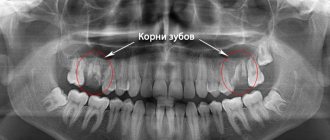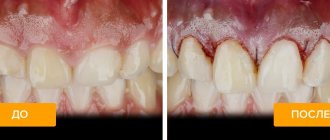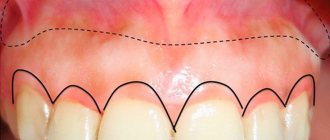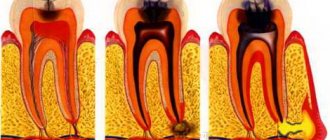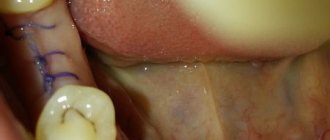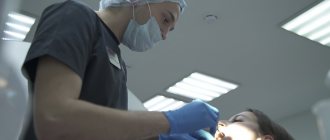Implantation involves the restoration of lost teeth. The purpose of the procedure is to restore not only chewing, but also aesthetic functions. Before the operation, the condition of the bone, mucous membranes, and neighboring teeth is taken into account. The function of bone tissue is to hold the implant and distribute the chewing load on the support. The function of mucous tissue is to protect the bone, provide access to nutrients, and protect against infection. Therefore, for implantation to be successful, it is necessary to have a sufficient amount of bone tissue and healthy mucosa. If it is not enough, an increase is made.
The importance of sufficient gum volume during implantation
- Aesthetics . During implantation, not only the success of installing the implant itself is taken into account, but also the appearance of the structure relative to the dentition. Installation of an artificial root should not interfere with the fixation of the crown, prosthesis, or interfere with neighboring teeth. In this case, the aesthetic gingival contour must be recreated.
- Functionality . Soft tissues provide nutrition to the bone structure of the jaw and support implant structures. Therefore, even before installing implants, the doctor analyzes the volume and condition of the gums and decides whether augmentation is required.
- Prevention of rejection . A healthy mucous membrane that forms around the implant protects the structure from plaque and bacterial penetration, and reduces the risk of peri-implantitis.
Dental prosthetics with a ceramic crown
E.max ceramics were chosen to restore the tooth. E.max pressed ceramics are very durable and are ideal for prosthetics of posterior teeth on implants.
The crown for the implant was made in Dial-Dent’s own dental laboratory.
The panoramic image shows excellent integration of the implant into the jaw bone:
The crown is made with screw fixation on the implant - this allows, if necessary, to replace the crown without damaging the implant. The fixation site is covered with a tooth-colored composite, so it is visible only to a specialist.
Prosthetics on an implant completely restored the function and aesthetics of the dentition. The girl was very pleased with the result. She postponed solving other problems for financial reasons, but noted that indicating the timing and exact price of treatment in the estimate greatly helps to calmly plan everything, without turning a trip to the dentist into unnecessary financial stress.
The total cost of treatment was 155,850 rubles. This included computed tomography with interpretation in the Diagnocat program, installation of an Astra Tech dental implant using APRF technology, installation of a gum former, plastic surgery of soft tissues, taking impressions, making a dental crown, diagnostic images after implantation, anesthesia. The cost of each stage is detailed in the treatment estimate and in the checks issued to the patient. The funds spent can be partially returned using a tax deduction.
Indications for soft tissue augmentation
Gum augmentation is carried out when:
- initial lack of mucous tissue;
- loss as a result of improper installation of implants;
- exposure of the implant during operation.
Initial volume deficit
Insufficient soft tissue volume is manifested due to:
- prolonged absence of a tooth - both the bone and gums atrophy;
- wearing adhesive bridges - mechanical pressure has a bad effect on soft tissues;
- a thin biotype of the mucosa is a physiological feature of the body, in this case the extension is necessary to prevent a lack of soft tissue after implantation.
Errors when installing implants on the upper or lower jaw
Gum loss during implantation is possible if:
- mechanical damage at one of the stages of the operation;
- stretching soft tissue after suturing - healing occurs with defects;
- improper placement and pressure of the temporary prosthesis on the mucous membranes leads to slow growth and healing of the gums.
Exposing the artificial root
There are two types of gum around the tooth root:
- attached - motionless, fused with the periosteum;
- movable - moves when the lips and cheeks move.
Exposure of the implant neck occurs due to a lack of attached gum, which breaks off, sinks, and pockets form. This provokes inflammatory processes:
- mucositis - inflammation of the soft tissue around the artificial root without involving bone structures;
- Peri-implantitis is a more severe condition where bone tissue detaches from the implant.
In such cases, along with gum augmentation, a number of procedures are performed to eliminate inflammation.
Related articles:
- Center guarantees
- Our advantages
- Press about us
Dial-Dent specialists who performed dental implantation and prosthetics
- Orthopedic dentist S.V. Zukor – diagnosis, treatment planning, dental prosthetics with a ceramic crown.
- Implant surgeon T.R. Zhazykoev – installation of a dental implant, gum surgery.
- Dental technician D.V. Wolf – making a ceramic dental crown.
- Assistant surgeon L. Kharlamova.
- Dental assistant S. Mirvelova.
See examples of other works by Dial-Dent specialists here.
Make an appointment for a consultation by phone +7-499-110-18-04 or through the form on the website. You can ask questions about dental prosthetics to the chief doctor of the clinic, Sergei Vladimirovich Tsukor, at
At what stage of implantation is gingivoplasty performed?
If in case of bone grafting to replenish the volume of hard tissues, surgery is recommended as a previous stage of implantation, then augmentation of gingival tissues is allowed at different stages. Depending on the causes of gum deficiency, the procedure is performed during one of the stages:
- Before implantation . In case of initial deficiency of attached gum. But if the implant surgeon is skilled in perioplasty, the procedure is also possible during implantation.
- During implant installation . One-stage plastic surgery is indicated for thin gum biotypes, if there is not enough mucous membrane to cover the surgical area.
- During the opening of the implant after osseointegration. This period is often chosen for any indication. At the same stage, correction of errors after implantation is carried out. At the same time, the gum former is installed.
- After operation. It is carried out if the parameters of the mucous membranes were not taken into account in the early stages, and over time the implant neck became exposed. It is recommended to carry out the procedure as soon as possible to reduce the risk of bone recession and prevent rejection of the artificial root.
Installation of a dental implant
An Astra Tech dental implant was installed under local anesthesia. The implant is closed with a plug and sutured in the gum until complete healing (about 2 months).
To speed up the engraftment of the implant, a platelet-rich clot obtained from the patient’s blood was used (APFR technology). Own platelet mass is completely biocompatible, it improves healing, relieves inflammation, and accelerates the integration of the implant into the bone.
View two months after implantation:
There is a noticeable gap in the gums in the area of the implant, which, according to the treatment plan, will be eliminated at the next stage.
Methods
The surgical method is chosen by the doctor based on the gum parameters, width and thickness. Plastic surgery is performed using:
- using your own tissues from the intervention area;
- transplantation of a donor flap from the hard palate;
- application of collagen matrices or membranes.
Membranes are a progressive method of restoration. It differs from others in its high predictability, minimally invasiveness and short rehabilitation period.
Plastic surgery of soft tissues in the oral cavity: features of the procedure
Before the operation, in our clinic, we first conduct a consultation with the dentist and carefully plan the upcoming procedure. Treatment tactics are always agreed upon with the chief physician. If there is a deficiency of soft tissues, they are built up and their volume is increased using tissue from special donor areas in the oral cavity. And if there is an excess of periodontal tissue, the excess part is removed.
The operation is performed by a periodontist surgeon. He uses local or general anesthesia. It depends on the patient's wishes. During the operation, the edge of the gum is cut closer to the tooth or implant, the surface is cleaned of plaque, food debris, and dental deposits, and work begins with the soft tissue itself.
When performing a local operation, soft tissues are taken from the donor area (on the palate or in the area of the tubercle of the upper jaw) in the oral cavity, their surface is cleaned in a certain way to obtain a true donor graft and applied to the required exposed area.
Stages
The operation is performed within 30-60 minutes. If collagen membranes are used, the time is reduced to 10-15 minutes .
Preparation
The oral cavity is disinfected. If necessary, the doctor limits the surgical site from the rest of the mucosa.
Anesthesia
Infiltration or conduction anesthesia with nerve block is used. Painkillers and anesthetics approved by an allergist are used.
Plastic
Incisions are made in the gums (if the operation is performed simultaneously with implantation, no incisions are made). Depending on the clinical picture, local tissue is used to form the gum, a flap of the required size is applied, or a matrix is used.
Seams
Application of surgical sutures.
Tab
An inlay is a microprosthesis used to replace tooth defects and restore the anatomical shape of crowns. It can serve as a support for a short bridge (the so-called Maryland bridge), a splinting structure.
Dental inlays
Indications for production:
- Pathologies of hard dental tissues that cannot be replaced by filling: caries , increased abrasion, wedge-shaped (abfraction) defects , crown fractures, enamel hypoplasia, fluorosis;
- Defects in the dentition of 1–2 teeth (as a fixing element in temporary structures with an extended service life);
- Pathological mobility of teeth (splinting elements during orthopedic treatment of periodontitis - inflammation of periodontal tissues).
Advantages of inlays over direct restorations (“fillings”):
- Elimination of incorrect cavity formation (on the model and in the tooth it will have tight, precise contact with the walls and a single direction of insertion due to steep walls and a flat bottom);
- The possibility of more accurate and correct restoration of the correct anatomical shape and individual characteristics of the crown, the functional component (chewing);
- High-quality restoration of the contact point - the part of the crown in contact with adjacent teeth (optimal shape and position, smoothness) - this is important for the healthy condition of the gums;
- Possibility of additional correction before fixation (visually, radiologically, instrumentally);
- High color stability and durability.
Restrictions and contraindications:
- Very deep and hard-to-reach cavities (submerged under the gum);
- Low natural crown.
Classification:
- Inlay – completely surrounded by hard tooth tissues;
- Onlay – cover the internal slopes of the tubercles (protective overlay);
- Overlay – covers all surfaces except one (usually the outside);
- Pinlay – reinforced into tissue using pin(s).
For the manufacture of inlays, the following are used: metal alloys (cobalt-chromium, silver-palladium, gold), composite materials, ceramic masses, zirconium oxide.
Clinical and laboratory stages of making an inlay (indirect method):
- Creation of a cavity within the enamel and dentin with preventive expansion to avoid secondary caries ;
- Obtaining impressions and models;
- Making a wax reproduction of the future design;
- Conversion into a permanent material (casting, firing, milling, pressing);
- Checking the accuracy of manufacturing on the model and in the clinic, fixation.
With the direct manufacturing method, the formation from wax occurs directly in the cavity prepared in the tooth. The indirect method is most often used.
Recovery period - healing time, recommendations
After surgery, follow your doctor's recommendations:
- use a protective mouth guard to prevent damage to the surgical site;
- do not eat food during the first 5-10 hours , you can drink water after a couple of hours;
- don't smoke for 3 days;
- stick to a diet - take warm lean foods;
- carry out thorough hygiene - cleaning 2-3 times a day , it is not recommended to touch the surgical site with a brush, antiseptic drugs are used;
- take prescribed antibacterial drugs;
- limit physical activity.
The rehabilitation period depends on the volume of intervention and the chosen surgical method. On average, gums heal in 10-14 days.
Postoperative recovery
After gingivoplasty, the doctor will tell you what needs to be done during the period of soft tissue restoration. Healing lasts from several days to 2-3 weeks. During the postoperative period, patients at our clinic are recommended to:
- take painkillers as prescribed by your doctor;
- reduce physical activity;
- eat warm crushed food;
- exclude spicy foods from the diet;
- rinse the mouth with an antiseptic solution;
- Do not use a toothbrush to clean the suture site.
After the procedure, the swelling lasts up to 5 days, then it begins to subside. If the swelling does not disappear, or complications arise, you should immediately consult a doctor.
To correct a smile using soft tissue, gingivoplasty is the optimal procedure. It is absolutely safe, but there are risks, as with any surgical procedure.
This could be an allergic reaction to the anesthesia (which is extremely rare when using modern anesthetics) or a recurrence of gum recession. In case of relapse, re-treatment is carried out after six months. To avoid this, immediately inform your dentist about any existing diseases.
Some more interesting facts: how are metal-ceramic crowns created?
First, the doctor makes an impression of the patient’s teeth.
The process of creating metal-ceramic crowns is a very delicate, almost jewelry-like work:
- First, the doctor makes an impression of the patient's teeth;
- Based on the impression, a shape and metal crowns are created that completely match the shape of the teeth;
- The most difficult part of the work is applying a layer of porcelain to the metal base.
Thanks to the painstaking work of our specialists, metal-ceramic dentures are strong, durable, and provide a beautiful smile to our patients.
Come to the “22nd Century” clinic: we will be happy to provide you with quality services!
Date of publication: September 20, 2020 Last update: September 22, 2021 © 2020 Professorial Dentistry “22 Century”. All rights reserved.
Reviews
This technique is used in almost all domestic dental clinics. Its result is the elimination of discomfort, correct bite and excellent aesthetic content.
If you have experienced the pros and cons of this method of prosthetics from your own experience, you can leave your comment in the appropriate section. Undoubtedly, some of our readers will find this useful.
If you find an error, please select a piece of text and press Ctrl+Enter.
Tags artificial gum implantation
Did you like the article? stay tuned
No comments yet
Why should you contact the 22nd Century Clinic?
The quality and cost of a metal-ceramic crown may vary in different clinics.
The quality and cost of a metal-ceramic crown may vary in different clinics. If the prosthesis is made of high-quality modern materials , then it can really be the best way to restore a lost tooth. If outdated materials and equipment are used, then cermets are unlikely to be a full-fledged replacement; they will quickly collapse.
At the “22 Century” clinic you can install high-quality, durable dentures:
- Professors and researchers with a high level of professionalism and extensive experience work for you;
- We use modern metal alloys and durable porcelain coatings;
- The clinic’s equipment allows us to produce precise metal frames that completely match the shape of the destroyed tooth.
Thanks to this, we have numerous positive reviews from our patients.
